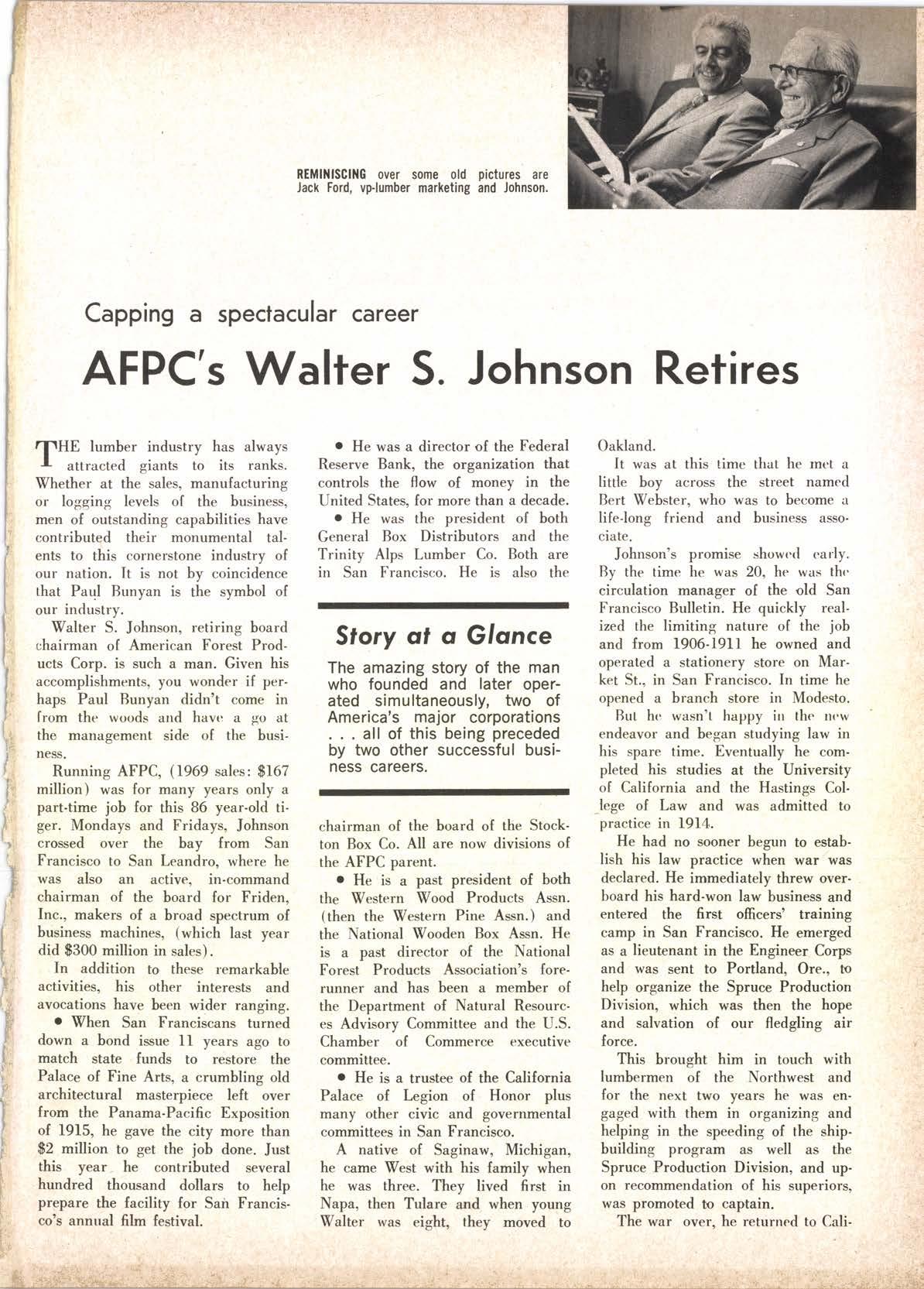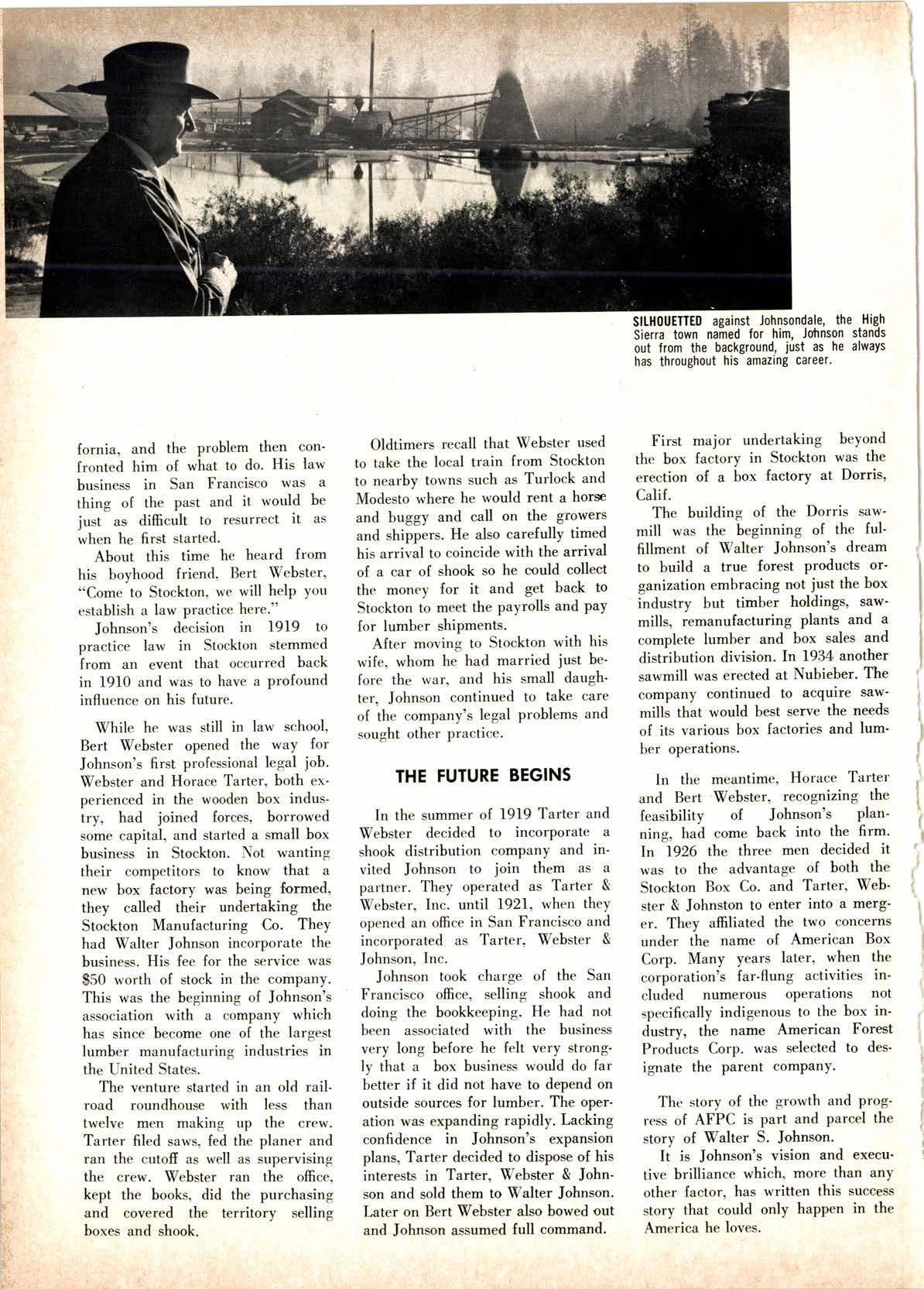
6 minute read
AFPC's Walter S. Johnson Retires
,THE lumber industry has always I attracted eiants to its ranks. W'hether at the sales, manufacturing or logging levels o{ the business, men of outstanding capabilities have contributed their monumental talents to this cornerstone industry of our nation. It is not by coincidence that Paul Bunyan is the symbol of our industry.
Walter S. Johnson, retiring board ohairman of American Forest Products Corp. is such a man. Given his accomplishments, you wonder if perhaps Paul Bunyan didn't come in from the woods artd havt, a so at the management side of the business.
Running AFPC, (1969 sales: $167 million) was for many years only a part-time job for this 86 year-old tiger. Mondays and Fridays, Johnson crossed over the b"y from San Francisco to San Leandro, where he was also an active. in-command chairman of the board for Friden, Inc., makers of a broad spectrum of business machines, (which last year did $300 million in sales).
In addition to these remarkable activities. his other interests and avocations have been wider ranging.
o When San Franciscans turned down a bond issue lI years ago to match state funds to restore the Palace of Fine Arts, a crumbling old architectural masterpiece left over from the Panama-Pacific Exposition of 1915, he gave the city more than $2 million to get the job done. Just this year - he contributed several hundred thousand dollars to help prepare the facility for San Francisco's annual film festival.
. He was a director of the Federal Reserve Bank, the organization that controls the flow of money in the United States, for more than a decade.
. He was the president of both General Box Distributors and the Trinity Alps Lumber Co. Both are in San Francisco. He is also the
Story dt o Glqnce
The amazing story of the man who founded and later oper- ated simultaneously, two of America's major corporations all of this being preceded by two other successful business careers.
chairman o{ the board of the Stockton Box Co. All are now divisions of the AFPC parent.
o He is a past president of both the Western Wood Products Assn. (then the Western Pine Assn.) and the National Wooden Box Assn. He is a past director of the National Forest Products Association's forerunner and has been a member of the Department of Natural Resources Advisory Committee and the U.S. Chamber of Commerce executive committee.
o He is a trustee of the California Palace of Legion of Honor plus many other civic and governmental committees in San Francisco.
A native of Saginaw, Michigan, he came West with his family when he was three. They lived first in Napa, then Tulare and when young Walter was eight, they moved to
Oakland.
It was at this time that he rnet a little boy across the street named Bert Webster, who was to become a life-long friend and business associate.
Johnson's promise showrrl early. By the time he was 200 he was thc circulation manager of the old San Francisco Bulletin. He quickly realized the limiting nature of the job and from 1906-1911 he owned and operated a stationery store on Market St., in San Francisco. In time he opened a branch store in Modesto.
But hc wasn't happy in the ncw endeavor and began studying law in his spare time. Eventually he completed his studies at the Urriversity of California and the Hastings Col. lege of Law and was admitted to practice in 1914.
He had no sooner begun to establish his law practice when war was declared. He immediately threw overboard his hard-won law business and entered the first officers' training camp in San Francisco. He emerged as a lieutenant in the Engineer Corps and was sent to Portland, Ore., to help organize the Spruce Production Division, which was then the hope and salvation of our fledgling air force.
This brought him in touch with lumbermen of the Northwest and for the next two years he was engaged with them in organizing and helping in the speeding of the shipbuilding program as well as the Spruce Production Division, and upon recommendation of his superiors, was promoted to captain.
The war over. he returned to Cali- fornia, and the problem then confronted him of what to do. His law business in San Francisco was a thing o{ the past and it would be just as difficult to resurrect it as when he first started.
About this time he heard from his boyhood friend, Bert Webster, "Come to Stockton, we will helP You establish a law practice here."
Johnson's decision in f919 to practice law in Stockton stemmed from an event that occurred back in 1910 and was to have a Profound influence on his future.
While he was still in law school, Bert Webster opened the way for Johnson's first professional legal job. Webster and Horace Tarter, both ex' perienced in the wooden box indus' try, had joined forces, borrowed some capital, and started a small box business in Stockton. Not wanting their competitors to know that a new box factory was being formed, they called their undertaking the Stockton Manufacturing Co. They had Walter Johnson incorporate the business. His fee for the service was $50 worth of stock in the company. This was the beginning of Johnson's association with a company which has since become one of the largest lumber manufacturing industries in the United States.
The venture started in an old railroad roundhouse with less than twelve men making up the crew. Tarter filed saws, fed the planer and ran the cutofi as well as supervising the crew. Webster ran the office, kept the books, did the purchasing and covered the territory selling boxes and shook.
Oldtimers recall that Webster used to take the local train from Stockton to nearby towns such as Turlock and Modesto where he would rent a horse and buggy and call on the growers and shippers. He also carefully timed his arrival to coincide with the arrival of a car of shook so he could collect the money for it and get back to Stockton to meet the payrolls and pay {or lumber shipments.
After moving to Stockton with his wife, whom he had married just be' fore the war, and his small daugh' ter. Johnson continued to take care o{ the company's legal problems and sought other practice.
The Future Begins
In the summer of l9l9 Tarter and Webster decided to incorPorate a shook distribution company and invited Johnson to join them as a partner. They operated as Tarter & Webster, Inc. until 1921, when theY opened an office in San Francisco and incorporated as Tarter, Webster & Johnson, Inc.
Johnson took charge of the San Francisco office, selling shook and doing the bookkeeping. He had not been associated with the business very long before he felt very strongly that a box business would do far better if it did not have to depend on outside sources for lumber. The operation was expanding rapidly. Lacking confidence in Johnson's expansion plans, Tarter decided to dispose of his interests in Tarter, Webster & Johnson and sold them to Walter Johnson. Later on Bert Webster also bowed out and Johnson assumed full command.
out from the background, just as he always has throughout his amazing career.
First major undertaking beYond the box factory in Stockton was the erection of a box factory at Dorris, Calif.
The building of the Dorris sawmill was the beginning of the ful' fillment of Walter Johnson's dream to build a true forest Products or' ganization embracing not just the box industry but timber holdings, saw' mills, rernanufacturing plants and a complete lumber and box sales and distribution division. In 1934 another sawmill was erected at Nubieber' The company continued to acquire saw' mills that would best serve the needs of its various box {actories and lum' ber operations.
In the meantime, Horace Tarter and Bert Webster, recognizing the feasibility of Johnson's Plan' ning, had come back into the firm. ln 1926 the three men decided it was to the advantage of both the Stockton Box Co. and Tarter, Web' ster & Johnston to enter into a merg' er. They affiliated the two concerns under the name of American Box Corp. Many years later, when the corporation's far'flung activities included numerous oPerations not specifically indigenous to the box in' dustry, the name American Forest Products Corp. was selected to designate the parent comPany.

The story of the growth and Progress of AFPC is part and Parcel the story of Walter S. Johnson.
It is Johnson's vision and execu' tive brilliance which, more than any other factor, has written this success story that could onlY haPPen in the America he loves.










